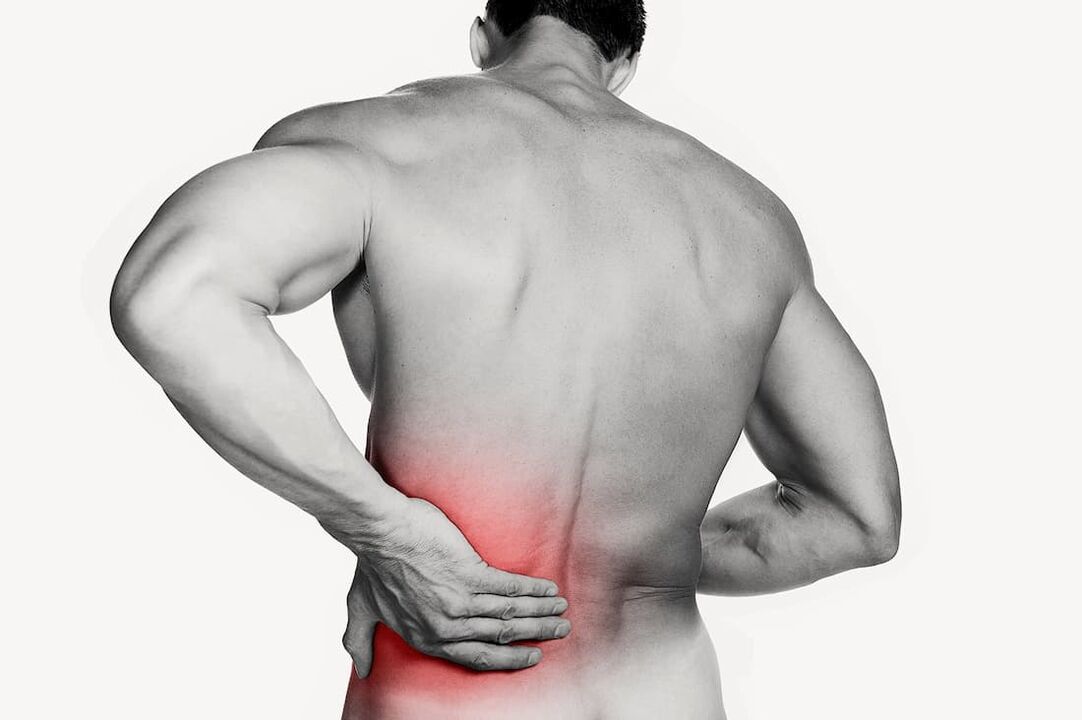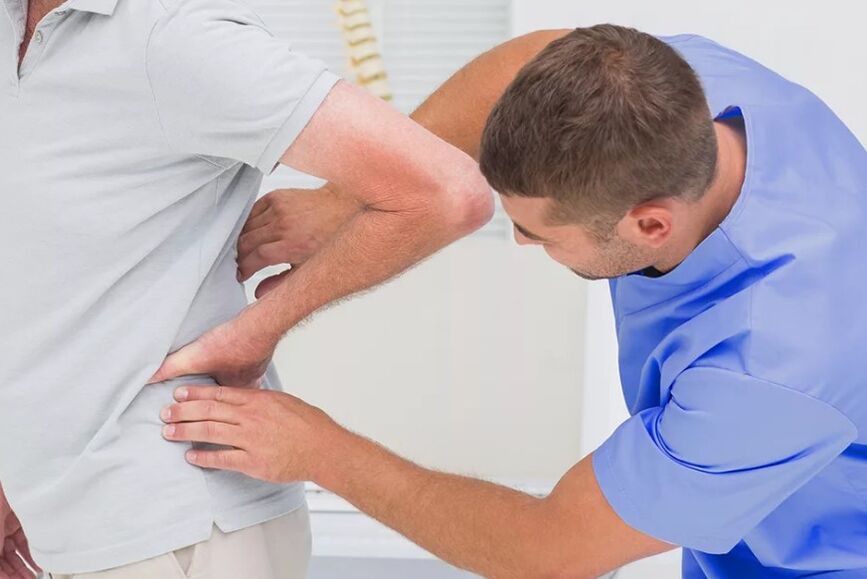
Low pain is the symptom to which it is rarely paid.Most people associates it with work in a sitting position, lifting weights or osteochondrosis and is in no hurry to see a doctor.In fact, this condition can report the diseases of the kidneys, liver or intestine and problems with the musculoskeletal system will not go by itself.Only a timely inspection of a specialist and a complete exam will help identify the cause of pain and choose the right treatment.
General information
The lower part of the back is an area that lives a significant load due to being in a vertical position.The spinal column is represented by five large vertebrae, which are also strengthened by the muscle frame.9 out of 10 cases of pain in this area are precisely caused by the pathology of the musculoskeletal system: osteochondrosis, muscle spasm, hernia of the intervertebral disc, pinching of the nervous root.
The remaining 10% of cases is associated with diseases of the internal organs located in the projection of the lower back: kidneys, parental parent system, intestine, liver.Even a doctor, during the examination, cannot always determine the cause of pain, which is why this condition requires a complete laboratory and instrumental diagnosis.
Types of pain
The first thing the doctor asks is the nature of the sensations.Depending on the cause that caused it, back pain can be:
- Acute: usually it is bruscily characterized by high intensity;The duration of the sensations is not exceeding 1.5 months;
- Subacuto: lasts 6-12 weeks;
- Chronic: sensations of any intensity that lasts 12 weeks or more;
- Transfer (variable): it appears periodically;
- Dolorly;
- ASSTITUIT;
- Strong, medium, weak intensity.
This division is conditional.Depending on the situation and circumstances, the nature and duration of the sensations may vary.It is important to describe them as completely as possible.
Reasons
The reasons why the back begins to hurt in the lower back.Very often, stimulating factors need:
- hypothermia;
- weight lifting;
- distribution of the irregular load (against the background of pregnancy, posture disorders, pathology of the musculoskeletal system);
- infectious injury;
- Diseases of the musculoskeletal system;
- inflammatory processes, including autoimmune;
- For a long time staying in an uncomfortable position;
- change in the composition of the bone tissue (osteoporosis);
- Volumetric processes: benign and evil tumors, abscesses;
- hormonal changes (menstruation, pregnancy, menopause);
- Renal diseases (urolithiasis, pyelonefrite, glomerulonefrite, abscesses);
- pathology of the gastrointestinal tract;
- Uterus and appendages diseases in women, prostate in men, etc.
Illnesses
Low pain can be a symptom of various diseases of the musculoskeletal system and internal organs.The main task of the doctor is to find out what exactly caused the deterioration of the condition and adopt the necessary measures.
Here are more common pathologies.
Ankylosing spondylitis
This is a systemic inflammatory disease, in which individual vertebrae occur in a single conglomerate.At the same time, a calcium deposit occurs in the ligaments that stabilize the spine, following which the affected area almost completely loses mobility.
The distinctive characteristics of back pain with ankylosing spondylitis include:
- an increase in rest at rest, in particular with prolonged research in a horizontal position;
- constraint of movements in the lumbar region;
Lumbar column osteochondrosis
This is a very common disease, in which intermittent discs are thinner, performing the role of shock absorbers.Consequently, the nerve roots and cramps of the surrounding muscles that cause severe pain are irritated.At the advanced phase of the disease, an intervertebral disk hernia is formed, which can press on the spinal cord, improving pain.
With osteochondrosis, pain intensifies:
- when it rises from a sedentary or horizontal position;
- When trying to lie on the stomach;
- With inclinations.
If the disease causes the formation of a massive hernia, the pain in the lower back is often accompanied by the intorpidement and weakness of one or both legs.
The curvature of the spine in the lumbar region (cifosi, scoliosis)
Pain in this pathology occurs in the central and late phase of the development of the disease.The discomfort usually occurs by the end of the day and is often accompanied by the effort of the spinal muscles.The pain is most often caused by the cramps of the muscles of the spine and it is also possible to explore the muscles to the removal (gluteal, periosemantal muscles of the upper and lower limbs).
Spondylartosis
This is a degenerative dyeing disease of the cartilage, which covers intervertebral discs.It is gradually more subtle and destroyed, bone growth (osteophytes) appear around the injury area.As a result of a reduction in the distance between the vertebrae, the narrow spinal canal, the nerve roots and the spinal cord are irritated.
Pain with this pathology:
- It intensifies after the load (supporting in the long term in the erect position, walking) and passes after rest;
- accompanied by the rigidity of the movements, first in the morning, then constant;
- It can be given to the thigh and the hip joint area.
The muscles in the injury area are spasmodic and constantly in tension, which also improves pain.
Urolina disease
An attack by Urolitiasi is characterized by severe lumbar pain by the affected kidneys.At the same time, the sensations do not change according to the laying, a person cannot find a position in which at least a little weakens.The attack is often accompanied by a reduction in the quantity of urine and a change in its color to the reddish.
Low pain can also be a consequence:
- Algomenor (painful menstruation);
- pregnancy;
- Pancreatic inflammation;
- osteomyelitis;
- intestinal obstruction;
- Appendicitis, etc.
Pain in various parts of the rear part
The location of pain can say a lot about their cause.Pain in the upper part of the lumbar region can be a consequence:
- spine diseases;
- injuries;
- muscle spasm on the background of their overvoltage;
- cardiovascular diseases;
- tumors;
- Diseases of the gastrointestinal tract.
If the epicenter is located in the lower part of the lower back, the list of probable motifs includes, in addition to the diseases of the spine:
- Renal pathology (Pyelonephritte, Urolitiasis);
- intestinal interruption (constipation, flatulence);
- Spasms or inflammatory process in the pelvic organs (salpingoo -fiorititis, endometritis);
- physiological causes, in particular, pregnancy;
- Pinch the sciatic nerve.
The movement of pain to the right or left can indicate the injury of the corresponding spine of the spinal cord, the kidneys.
Diagnostics
The diagnosis of back pain requires a complete examination.The first phase of the search for the reason is the survey.The doctor clarifies:
- Location of pain;
- its character and duration;
- causes that cause an attack or improve pain;
- Circumstances in which the condition improves (a certain pose, immobility, taking drugs, etc.).
The data on lesions and diseases, the chronic pathologies already identified are collected without fail.A further possible diagnostic research to the doctor's discretion includes:
- General blood and urine test: it helps identify the inflammatory process in the body, kidney pathology;
- Biochemical blood test to identify signs of renal damage, pancreas, liver and gallbladder, etc.;
- Ultrasound of the abdominal organs and the pelvis, in men - ultrasound of the prostate gland;
- Ultrasound of the kidneys;
- X -ray, coach or magnetic resonance imaging of the lumbar column;
- X -Reggi of the chest.
In case of suspicion of any pathology after a diagnosis and inspection of review, more targeted tests, exams and consultations of restricted specialists are prescribed.They allow you to clarify or refute the diagnosis.

Treatment
The treatment of pain in the lower back depends on its cause.A neurologist, a urologist, a gynecologist and a surgeon can engage in a pathology.If we are talking about diseases of the musculoskeletal system, doctors use medical, non -pharmacological and surgical methods to improve the patient's condition.
Pharmacological treatment
The most common means to eliminate lumbar pain are anti -anti -inflammatory drugs non -pounds (NSAIDs).They are prescribed in the form of tablets, intravenous and intramuscular injections, rectal suppositories, as well as creams, ointments and patches for local use.The decision on the dosage of the product, as well as the duration of the course, is taken by the doctor, since the uncontrolled use of these drugs can cause unpleasant side effects.
If fans are ineffective, doctors prescribe hormonal drugs (corticosteroids).They also stop the inflammatory process and help reduce pain.
The third group of drugs that improve the patient's condition is antispasmodic.The muscle cramps are removed in the lower back.
In addition, they can be appointed:
- decongestant to reduce the edema of a pinched root;
- Vitamins B to improve nervous conduction;
- sedatives.
Non -pharmacological methods
The non -drug treatment completes medicinal schemes.Depending on the clinical situation, it may include:
- physiotherapy procedures (magnetotherapy, laser effect, electrophoresis, etc.);
- Physiotherapy exercises: the course of the exercises is developed individually according to the main and related diseases;Gymnastics should be performed regularly, not only in the clinic office, but also at home, only in this case does it have an effect;
- General strengthening and therapeutic massage (carried out outside the exacerbations);
- acupuncture;
- Manual therapy and assistance to the osteopath.
Surgical treatment
The help of the surgeon is necessary if the attending physician on the basis of the general picture reveals one of the indications for surgical treatment.The presence of an intervertebral disc hernia is not an indication for surgical treatment, regardless of its size.Depending on the indications, doctors can remove the hernia of the intervertebral disc, eliminate the compression of the roots of the spinal cord, remove the tumor, etc.The decision to conduct a particular operation is taken individually.
Prevention
The most effective way to prevent back pain is adjusting your lifestyle to save the kidneys, the spine and the pelvic organs, but if the pain was often presented, this should be the reason for an extraordinary appeal to a specialist:
- avoid hypothermia;
- prevent hypodynamia;
- Practicing sports at amateur level (swimming is particularly beneficial affects the condition of the spine and back muscles);
- Correctly and balanced to eat: prevent excessive food, minimize fatty food, spicy and too salty;
- exclude alcohol and nicotine;
- Drink at least 1.5 liters of pure water every day without taking into consideration tea, coffee or juices;
- Keeping the body mass index at a normal level: excess weight does not affect the conditions of the spine and the deficiency can cause renal veneration.
If a person has already diagnosed the pathology of the musculoskeletal system, preferably at least twice a year, according to the European recommendations for the rehabilitation of the pathology of the spine, to undergo preventive courses in accordance with the appointment of a doctor.























